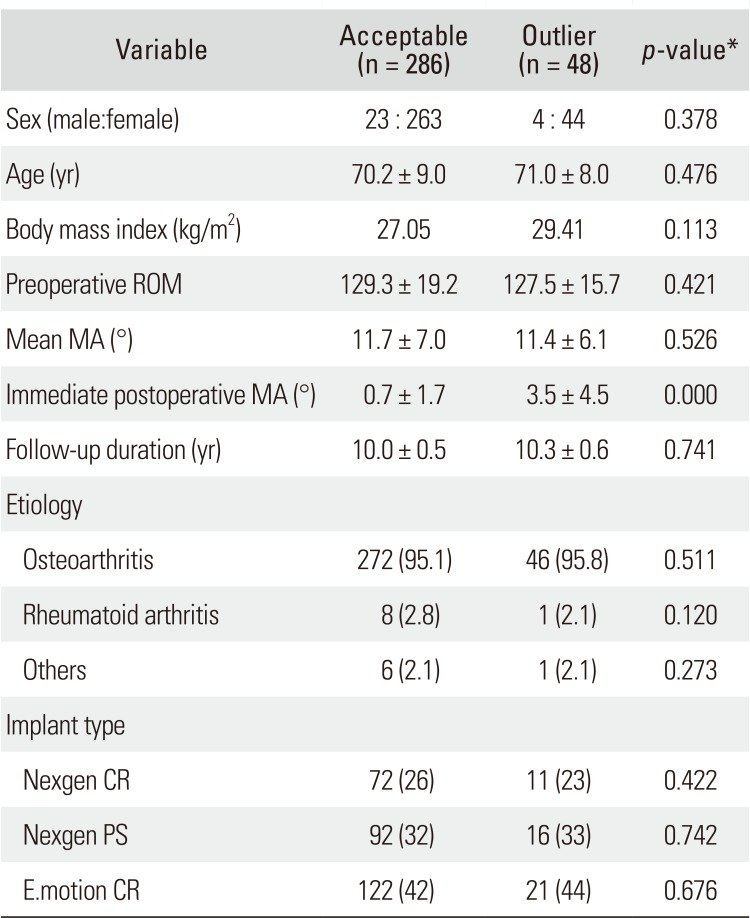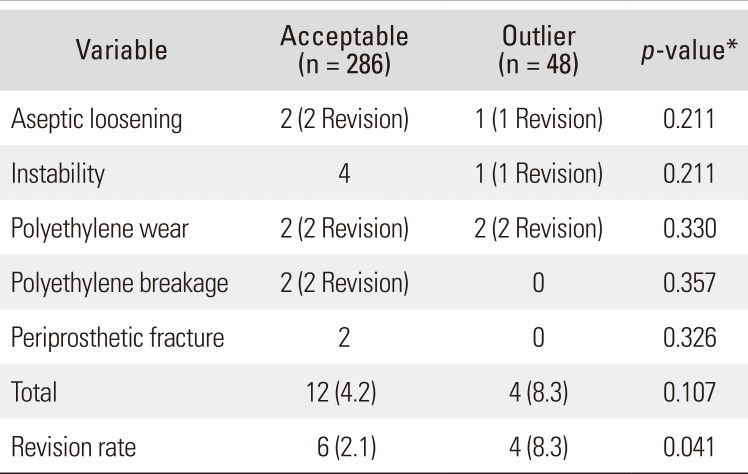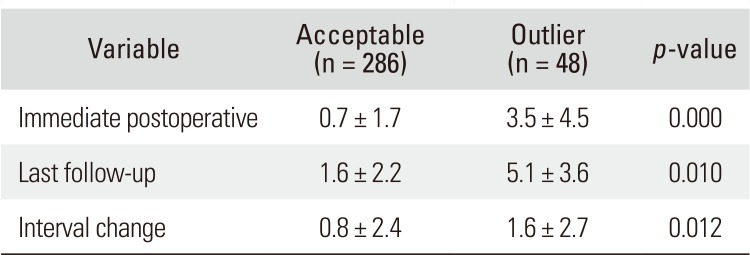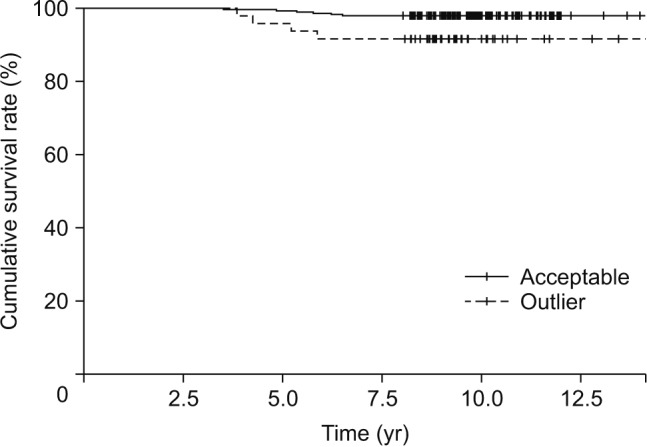1. Jeffery RS, Morris RW, Denham RA. Coronal alignment after total knee replacement. J Bone Joint Surg Br. 1991; 73(5):709–714. PMID:
1894655.

2. Bauwens K, Matthes G, Wich M, et al. Navigated total knee replacement: a meta-analysis. J Bone Joint Surg Am. 2007; 89(2):261–269. PMID:
17272438.
3. Matziolis G, Krocker D, Weiss U, Tohtz S, Perka C. A prospective, randomized study of computer-assisted and conventional total knee arthroplasty: three-dimensional evaluation of implant alignment and rotation. J Bone Joint Surg Am. 2007; 89(2):236–243. PMID:
17272435.
4. Bourne RB, Chesworth BM, Davis AM, Mahomed NN, Charron KD. Patient satisfaction after total knee arthroplasty: who is satisfied and who is not? Clin Orthop Relat Res. 2010; 468(1):57–63. PMID:
19844772.

5. Bargren JH, Blaha JD, Freeman MA. Alignment in total knee arthroplasty: correlated biomechanical and clinical observations. Clin Orthop Relat Res. 1983; (173):178–183.
6. Howell SM, Howell SJ, Kuznik KT, Cohen J, Hull ML. Does a kinematically aligned total knee arthroplasty restore function without failure regardless of alignment category? Clin Orthop Relat Res. 2013; 471(3):1000–1007. PMID:
22996362.

7. Howell SM, Papadopoulos S, Kuznik KT, Hull ML. Accurate alignment and high function after kinematically aligned TKA performed with generic instruments. Knee Surg Sports Traumatol Arthrosc. 2013; 21(10):2271–2280. PMID:
23948721.

8. Hsu RW, Himeno S, Coventry MB, Chao EY. Normal axial alignment of the lower extremity and load-bearing distribution at the knee. Clin Orthop Relat Res. 1990; (255):215–227.

9. Hvid I, Nielsen S. Total condylar knee arthroplasty: prosthetic component positioning and radiolucent lines. Acta Orthop Scand. 1984; 55(2):160–165. PMID:
6711282.

10. Lotke PA, Ecker ML. Influence of positioning of prosthesis in total knee replacement. J Bone Joint Surg Am. 1977; 59(1):77–79. PMID:
833180.

11. Ritter MA, Faris PM, Keating EM, Meding JB. Postoperative alignment of total knee replacement: its effect on survival. Clin Orthop Relat Res. 1994; (299):153–156. PMID:
8119010.

12. Bellemans J, Colyn W, Vandenneucker H, Victor J. The Chitranjan Ranawat award: is neutral mechanical alignment normal for all patients? The concept of constitutional varus? Clin Orthop Relat Res. 2012; 470(1):45–53. PMID:
21656315.

13. Choong PF, Dowsey MM, Stoney JD. Does accurate anatomical alignment result in better function and quality of life? Comparing conventional and computer-assisted total knee arthroplasty. J Arthroplasty. 2009; 24(4):560–569. PMID:
18534397.

14. Longstaff LM, Sloan K, Stamp N, Scaddan M, Beaver R. Good alignment after total knee arthroplasty leads to faster rehabilitation and better function. J Arthroplasty. 2009; 24(4):570–578. PMID:
18534396.

15. Bland JM, Altman DG. Statistical methods for assessing agreement between two methods of clinical measurement. Lancet. 1986; 1(8476):307–310. PMID:
2868172.

16. Tew M, Waugh W. Estimating the survival time of knee replacement. J Bone Joint Surg Br. 1982; 64(5):579–582. PMID:
7142266.

17. Berend ME, Ritter MA, Meding JB, et al. Tibial component failure mechanisms in total knee arthroplasty. Clin Orthop Relat Res. 2004; (428):26–34.
18. D'Lima DD, Chen PC, Colwell CW Jr. Polyethylene contact stresses, articular congruity, and knee alignment. Clin Orthop Relat Res. 2001; (392):232–238.
19. D'Lima DD, Hermida JC, Chen PC, Colwell CW Jr. Polyethylene wear and variations in knee kinematics. Clin Orthop Relat Res. 2001; (392):124–130.
20. Ensini A, Catani F, Leardini A, Romagnoli M, Giannini S. Alignments and clinical results in conventional and navigated total knee arthroplasty. Clin Orthop Relat Res. 2007; 457:156–162. PMID:
17195810.

21. Sikorski JM. Alignment in total knee replacement. J Bone Joint Surg Br. 2008; 90(9):1121–1127. PMID:
18757949.

22. Schiavone Panni A, Falez F, D'Apolito R, Corona K, Perisano C, Vasso M. Long-term follow-up of a non-randomised prospective cohort of one hundred and ninety two total knee arthroplasties using the NexGen implant. Int Orthop. 2017; 41(6):1155–1162. PMID:
28326442.

23. Howie DF, Love GJ, Deakin AH, Kinninmonth AW. Intraoperative deviation in limb alignment occurring at implantation in total knee arthroplasty. Knee. 2015; 22(1):47–50. PMID:
25476128.

24. Matziolis G, Adam J, Perka C. Varus malalignment has no influence on clinical outcome in midterm follow-up after total knee replacement. Arch Orthop Trauma Surg. 2010; 130(12):1487–1491. PMID:
20165859.

25. Parratte S, Pagnano MW, Trousdale RT, Berry DJ. Effect of postoperative mechanical axis alignment on the fifteen-year survival of modern, cemented total knee replacements. J Bone Joint Surg Am. 2010; 92(12):2143–2149. PMID:
20844155.

26. Bellemans J. Neutral mechanical alignment: a requirement for successful TKA: opposes. Orthopedics. 2011; 34(9):e507–e509. PMID:
21902146.

27. Vanlommel L, Vanlommel J, Claes S, Bellemans J. Slight undercorrection following total knee arthroplasty results in superior clinical outcomes in varus knees. Knee Surg Sports Traumatol Arthrosc. 2013; 21(10):2325–2330. PMID:
23552665.

28. Green GV, Berend KR, Berend ME, Glisson RR, Vail TP. The effects of varus tibial alignment on proximal tibial surface strain in total knee arthroplasty: the posteromedial hot spot. J Arthroplasty. 2002; 17(8):1033–1039. PMID:
12478515.
29. Liau JJ, Cheng CK, Huang CH, Lo WH. The effect of malalignment on stresses in polyethylene component of total knee prostheses: a finite element analysis. Clin Biomech (Bristol, Avon). 2002; 17(2):140–146.
30. Mason JB, Fehring TK, Estok R, Banel D, Fahrbach K. Metaanalysis of alignment outcomes in computer-assisted total knee arthroplasty surgery. J Arthroplasty. 2007; 22(8):1097–1106. PMID:
18078876.








 PDF
PDF ePub
ePub Citation
Citation Print
Print




 XML Download
XML Download